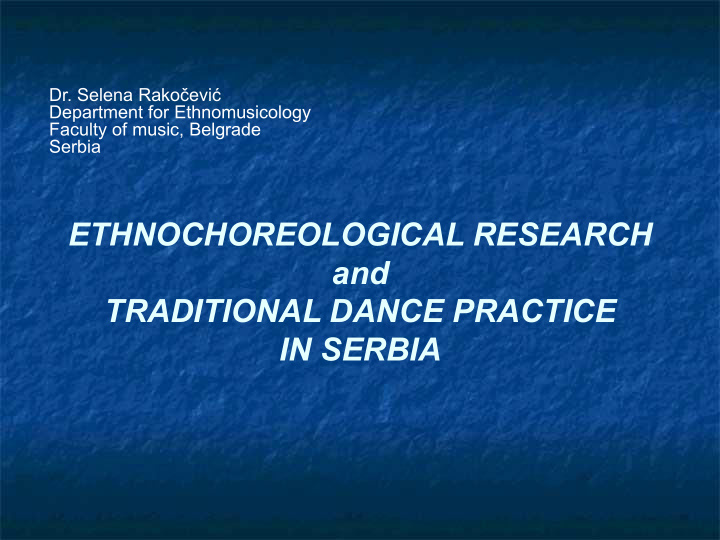



Dr. Selena Rakočević Department for Ethnomusicology Faculty of music, Belgrade Serbia ETHNOCHOREOLOGICAL RESEARCH and TRADITIONAL DANCE PRACTICE IN SERBIA
Structure and content of the lecture The concept of ethnochoreology Main researchers Ethnochoreological areas
Ethnochoreology is a scientific discipline dedicated to research of traditional (folk) dance The term appeared in the late 1950s in the East Europe Ethnochoreological research exist all across Europe at the university levels Study group on Ethnochoreology of the International Council for Traditional Music (ICTM) since 1962
Ethnochoreology in Serbia appeared in 1934 (The first book of the edition Folk dance by the sisters Ljubica and Danica Janković) Ethnochoreology as one of the main subjects exists at the ethnomusicological studies (bachelor, master and PhD level) at the Faculty of Music, University of Arts in Belgrade since 1990 and at the Academy of Arts in Novi Sad since 2000
Ljubica (1894-1974) and Danica Janković (1898 -1960) Folk dances , eight books, 1934-1964
The Janković sisters Intense field research 1925-1950 Dance notation system Detailed descriptions of approx. 900 dances Many scientific texts about folk dances Ljubica become a mamber of the Serbian Academy of Scinece and Arts AS ETHNOCHOREOLOGIST in 1964 Field research Dance notation photos
Olivera Vasić The legatee of the Janković sisters Intense field researc Ethnochoroeological areas Ritual dances Many scientific papers and books Labanotation Olivera Vasić 1947 - Filming folk dance Academic ethnochoreological education in Belgrade, Novi Sad, Banja Luka and Skopje Center for folk dance research since 1991 Labanotation of Kolo in three dance Field research photos
Ethnochoreological areas in Serbia Based on differential characteristics of their dance traditions Northern Central Western Northeastern and, Southeastern ethnochoreological area.
Central Serbia Kolo formation (semicircle) Holding: so-called V possition Repertoire Šetnja ( povoz, povozito ) / devojačko kolo Kolo in three/kolo (many various names such are: moravac , Photo: Magazine Folklore kukunješ , Žikino kolo , retko kolo , moravsko kolo, užičko kolo ) Individual dances: rudničanka, čačanka, stara vlahinja, trojanac, osmica, kriva, gajdica, polomka, đurđevka etc. So-called city dances ( bojerka , romunka , Srba , kraljevo kolo, seljančica etc) Style: soft knees and hocks, bending, leaping, vibrations, various crossing steps, triple steps, leg swings, prancing Dance music: vocal-instrumental and Instrumental (frula, dvojnice, accordion, small string ensembles) Photo: National ansamble KOLO www.kolo.rs
Western Serbia Kolo formation (semicircle) Holding: so-called V possition Repertoire Šetnja ( povoz, povozito ) / devojačko kolo Kolo in three/kolo (many various names such are: moravac , Photo: kukunješ , Žikino kolo , retko kolo , moravsko kolo, KUD “Đerdan”, Valjevo užičko kolo ) Individual dances: četvorak, trojanac, stari trojanac, osmica, čarlama, povijorac, đurđevka, sakajdo, čaldiš etc. Dances accompanied by a song, named after the first verse Style: strong dancing, long steps, crossing the space, triple-steps (no crossing steps), sharp knee bending, whole foot Dance music: vocal, vocal-instrumental and Instrumental (frula, dvojnice, accordion, small string ensembles) Photo: KUD “Stanko Paunović”, Pančevo
Northern Serbia (Vojvodina) Kolo formation (closed circle) Pairs, in trios (man between two women) Holding: so- called “holding from Vojvodina” Repertoire Kolos Veliko kolo, malo kolo ( banatsko, bačko , kolo na jednu stranu , paorsko kolo , gajdaško kolo , sitno kolo, Kolo vodi Vasa etc.) In pairs and trios Mađarac , po dvoje, ketuša, ficko, logovac Style: geneder differentiations, soft knees, prancing, varying (males), bouncing, polyrhythms in male dancing ( veliko kolo ) Dance music: Instrumental with possible shouting verses (bag-pipes, tamburitza ensembles) Photos: Magazine Folklore
Northeastern Serbia Kolo formation (semicircle) Holding: so-called V postion and cross-hands Repertoire Vlajna ( stara vlajna , četvorka ) Individual dances: keser , polomka , pop Marinkovo kolo , todorka , levakinja , zaplet, ruzmarin etc. Style: realtively strong dancing, hops, leaps, triple-steps (no crossing steps), bending, whole foot Dance music: Instrumental (frula, bag-pipes, small string ensembles) Photos: Magazine Folklore
Southeastern Serbia Kolo formation (closed and semicircle) Solo formation ( posame ) Holding: cross-hands Repertoire Ritual dances (koledari, kraljice, lazarice) Čačak ( krupan , sitan , banjski , svrljiški , niški , šilovački basara etc.) Individual dances: jednostranka , rumenka , osamputka , selsko oro , vlasinka , bugarka , pešački , posame , šestorke , pembe etc. Dances accompanied by a song, named after the first verse Style: realtively strong dancing, hops, leaps, triple-steps (no crossing steps), bending, whole foot Dance music: Vocal, vocal-instrumental and instrumental (frula, bag-pipes, zurle and tapan, brass bands) Photos: Magazine Folklore
Thank you for your attention
Recommend
More recommend